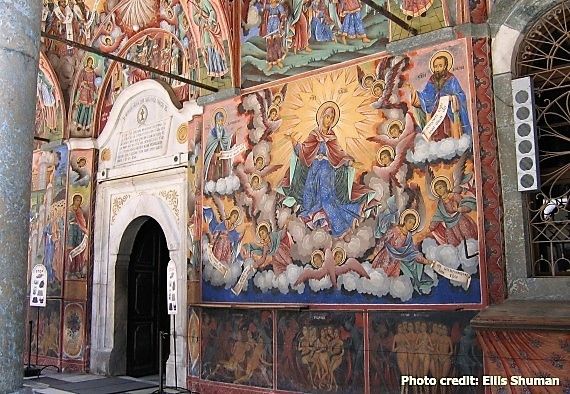Nestled in mountain forests an hour and a half south of Sofia, the Rila Monastery is Bulgaria’s most popular tourist destination. It is the country’s largest and most famous Eastern Orthodox monastery, attracting both the faithful and the curious. As a pilgrimage destination, it is known locally as the Jerusalem of Bulgaria.

My wife and I visited the Rila Monastery on a number of occasions, driving down from Sofia with our visitors from overseas. The monastery made such an impression on me that I staged a pivotal scene from my novel there. Walk through the arched entrance and your eyes will open wide with amazement.

The monastery’s fortress-like complex surrounds a huge, flagstone courtyard. The church in the centre of the plaza is the focus of attention. This amazing construction looks too surreal to be an actual house of worship. It is a square edifice with porches encased by graceful black-and-white striped arches. Below the arches, a brilliance of fresco murals completely covers the outer walls. The colourful, painstakingly restored frescoes depict Biblical scenes and Orthodox saints.
Atop the arches is a row of gargoyles, their details impossible to discern from a distance. A roof of grey interspersed with layers of red-and-white brick extends upward toward additional decorations. Rising above everything is the church’s main dome, one of five topping this unique building.

Beyond the tiled roofs, you can see thick greenery and in the distance, the rough upper peaks of the Rila range, white-peaked during most of the year. The word ‘harmony’ comes to mine. As well as ‘serenity’.
The church has a darkened interior, similar to that of many Eastern Orthodox sanctuaries, and houses many valuable icons. At the three altars and in the two side chapels the faithful light candles, intermingle with the black-robed, bearded priests.
The monastery is named after the hermit Ivan of Rila. Founded in the 10th century and located a short distance from the cave where he lived an ascetic life, the monastery has been destroyed and rebuilt repeatedly over the centuries. The monastery played a major role preserving the Bulgarian language and culture during the years of Ottoman rule. The present-day structure dates to the 1800s. During Bulgaria’s fight for independence from the Turks in the 1870s, it served as a hideout for the country’s heroic revolutionaries. Rila Monastery was declared a UNESCO World Heritage Site in 1983.

The Rila complex includes a museum housing the monastery’s most sacred treasure - Raphael’s Cross. This finely carved wood crucifix with 36 miniature scenes from the Bible was created over the course of many years until completed in 1802 when Father Raphael, for whom it is named, lost his sight.
There are a number of ways to get to the Rila Monastery. The drive south from Sofia is on well-maintained highways and the turnoff to the village of Rila and the monastery beyond is clearly marked. Regular bus service from the capital is infrequent, though, but there are day tours, some of them a bit expensive. As the Rila Mountains are a popular hiking destination, the adventurous can combine a trek with a monastery visit.

It is possible to stay overnight at the monastery in austere, monastic rooms, but these are primarily geared to pilgrims wishing to spend more time at the site. Due to its proximity to Sofia, a day trip is certainly sufficient for a visit. If you’re on a short business trip, or a holiday in the Bulgarian capital, it’s worth making a pilgrimage to see the Rila Monastery.